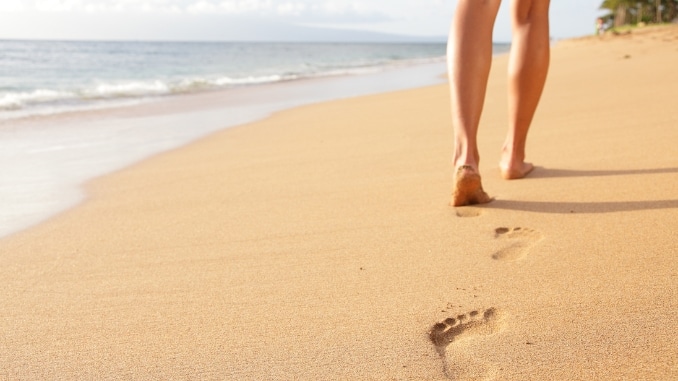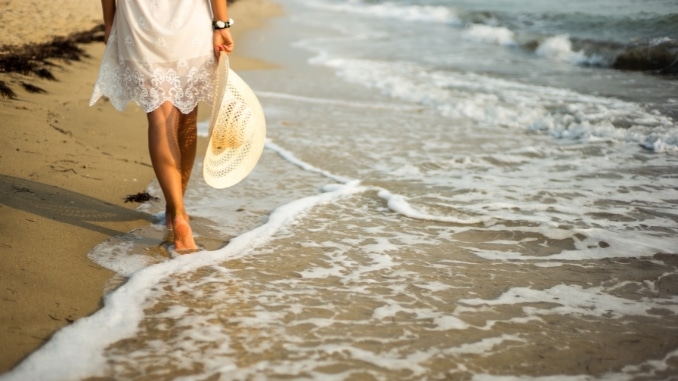Walking on the beach seems like a peaceful, breezy stroll—but don’t be fooled. That soft, shifting sand under your feet? It’s secretly turning your casual walk into a fat-burning workout.
So let’s answer the big question: Does walking on the beach [1] burn more calories?
‘Spoiler: Yes, it does. But there’s more to the story…
Why Beach Walking Burns More Calories Than Pavement Strolling

Sand requires more effort. Unlike hard surfaces like pavement or concrete, walking on the beach—especially in soft or loose sand—demands more from your foot muscles, leg muscles, and core to stabilize your body.
Your feet sink with each step, which means your muscles have to work harder to push off and keep you moving forward. That added resistance translates into more calorie burn.
Dr. Allen Conrad, a certified strength and conditioning coach and chiropractor, explains that walking on sand requires significantly more effort than walking on a hard surface, leading to a higher calorie burn. Specifically, he notes that
“Walking on sand activates muscles differently, resulting in approximately 1.5 to 2 times the calorie burn of walking on a hard surface”.
This increased calorie expenditure is due to the additional effort required to stabilize the body on the uneven surface of the sand, which engages accessory muscles in the legs and back more intensely than walking on solid ground.
So… How Many Calories Are We Talking About?
While calorie burn depends on your speed, weight, and distance, research suggests walking [2] on soft sand can burn up to 50% more calories than walking on a hard surface.
Want a number? A 160-pound person walking for 30 minutes at a moderate pace may burn:
- 149 calories on pavement
- 200–225 calories on soft sand
Yep, that’s a noticeable boost.
Surprising Health Benefits of Beach Walking

Beyond just helping you lose weight, walking on the beach comes with a wave of numerous health benefits:
- Supports immune health through exposure to fresh air and the negative ions produced by the ocean environment.
- Improves blood pressure by reducing stress and encouraging gentle physical activity.
- Relieves stress and tension—nothing calms the nervous system quite like the sound of waves.
- Strengthens joints and muscles, especially when walking barefoot on softer surfaces.
- Encourages better posture and balance with the unstable, new terrain of sand.
- Acts as a natural exfoliant for your skin, thanks to salt water and the sand texture.
Wet Sand vs. Soft Sand: What’s Better?
- Soft Sand (Dry) = Increased resistance, greater effort, higher calorie burn—but also more strain on muscles and joints.
- Wet Sand (Water’s Edge) = Still some resistance, but a bit firmer. Easier on joints. Ideal for beginners.
So if you’re just getting started? Start slowly along the water’s edge and gradually increase the difficulty by moving to loose sand.
Pros & Cons of Walking on the Beach
Pros:
- Burn more calories than walking on pavement
- Activates foot and leg muscles more intensely
- Supports weight loss [3] and toning
- Boosts mental health and helps reduce stress
- Natural, scenic way to stay fit
- Great for barefoot walking (and yes, it strengthens your toes and bones!)
- Exposes your body to vitamin D (with sun protection!)
Cons:
- Sharp shells or sharp objects can injure bare feet
- Sand training is tough—don’t overdo it too fast
- You might need to wear shoes on rougher beaches
- Sun exposure can be harsh—always wear sunscreen
- Uneven terrain can strain joints if you’re not careful
Pro Tips for Safer, More Effective Beach Walks

- Start slowly—especially if you’re new to this type of workout.
- Stick to wet sand at first for more stability.
- Wear shoes if the beach has sharp shells or debris.
- Always wear sunscreen and protect your skin.
- Bring a water bottle and drink plenty to stay hydrated.
- Don’t forget to listen to your body—sore muscles are okay, pain is not.
So… Should You Walk on the Beach for Exercise?
If you're looking for a simple way to burn calories, relieve stress, and give your muscles a fresh challenge, walking on the beach might be one of the most underrated ways to do it.
Whether you want to lose weight, boost your mental health, or just enjoy the fresh air, this sandy stroll offers real benefits for your body and mind.
So kick off your shoes (carefully), soak in the sun (with sunscreen!), and let your beach walk do more for your health than you ever imagined.
Bottom Line
Yes, walking on the beach burns more calories, but it also strengthens your body, soothes your soul, and gives your everyday walk a serious upgrade. Just be smart, start slow, and enjoy the ride.
Want to make your workouts feel like a vacation? The beach is waiting.
What if I told you 11 gentle stretches could help you increase your energy, lose weight, decrease pain, stiffness and stress, and make you happier? Check out this 11 Daily Stretches to Feel and Look Amazing!
Frequently Asked Questions
Does walking on the beach burn more calories than walking on pavement?
Yes, walking on the beach generally burns more calories than walking on pavement. The uneven texture of sand demands greater effort and activates additional muscle groups, leading to higher calorie expenditure.
How much more can I expect to burn while walking on sand?
Studies indicate that walking on soft sand may increase calorie burn by up to 50% compared to walking on a solid surface. For example, a 160-pound person may burn around 200-225 calories on sand versus 149 calories on pavement during a 30-minute walk.
What factors influence calorie burn while walking on the beach?
Calorie burn during beach walks is influenced by variables such as body weight, walking pace, distance covered, and the sand's texture (wet or dry). Heavier individuals and faster paces usually result in higher calorie burn.
Is it better to walk on wet sand or dry sand for burning calories?
Walking on dry sand typically requires more effort and burns more calories than wet sand. Wet sand provides more stability and makes it easier to walk, which may reduce calorie expenditure.
Can walking on the beach help with weight loss?
Yes, incorporating beach walks into your fitness routine can aid in weight loss. The increased calorie burn, combined with the benefits of fresh air and natural scenery, makes beach walking an enjoyable and effective form of exercise.





